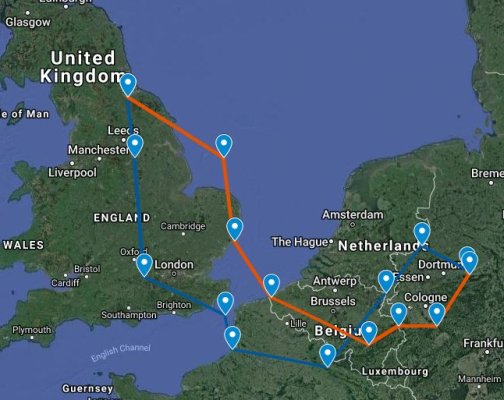I'm surprised nobody had any insights on my request above. However I have now completed putting down all 31 of the routes on Google maps and they are quite fascinating to review them and reflect back on what it would have been like to do all of this in the chaos of combat. I have had 4 phone calls with my father's navigator, still spry at 96 and with excellent recall!
I was unsuccessful in automating the "drawing feature" to connect "Turning Points" (waypoints). However I was able to come up with useful
for Great Circle Distances (Haversine formula) and also "Initial Bearings". For those who are interested...
Excel formula for Initial Bearing (True):
=ATAN2(COS(lat1)*SIN(lat2)-SIN(lat1)*COS(lat2)*COS(lon2-lon1),SIN(lon2-lon1)*COS(lat2)); where lats and longs are in radians. Note that the =radians() in excel gives a slightly different answer to latitude*22/7/180. Not sure why. Note that bearing actually changes slightly during longer distances, hence the term "initial bearing"
Excel formula for Great Circle Distances (Haversine formula):
2*ASIN(MIN(1,((SIN((Delta Latitude)/2))^2+((COS(Latitude1)*COS(Latitude2))*(SIN((Delta Longitude)/2)^2)))^0.5))*Earths radius,1)
, where Earth's radius is 6,371 km and again all coordinates in radians.
One can then concatenate the route instructions for the turning points into a "route paragraph" using some string formulas as well as the concatenate formula: Concatenate(text1,text2...). Here is a "route paragraph" for Dad's operation to Hanover, March 25, 1945:
From Base, set Course to TP2: Initial bearing 173.5 degrees T, Distance: 69.7 miles. Alter Course to TP3: Initial bearing 105.8 degrees T, Distance: 118.8 miles. Alter Course to TP4: Initial bearing 140 degrees T, Distance: 133.8 miles. Alter Course to TP5-On Track: Initial bearing 89.4 degrees T, Distance: 64.5 miles. Alter Course to TP6: Initial bearing 89.6 degrees T, Distance: 43 miles. Alter Course to TP7: Initial bearing 61.3 degrees T, Distance: 48.7 miles. Alter Course to TP8: Initial bearing 89.1 degrees T, Distance: 99.6 miles. Alter Course to TP9-On Track: Initial bearing 23.7 degrees T, Distance: 8.8 miles. Alter Course to Target Hannover: Initial bearing 23.8 degrees T, Distance: 32.9 miles. Alter Course to TP11: Initial bearing 27.4 degrees T, Distance: 6.3 miles. Alter Course to TP12: Initial bearing 304.5 degrees T, Distance: 10.2 miles. Alter Course to TP13: Initial bearing 223.7 degrees T, Distance: 68 miles. Alter Course to TP14: Initial bearing 270.6 degrees T, Distance: 64 miles. Alter Course to TP15: Initial bearing 242.1 degrees T, Distance: 48.7 miles. Alter Course to TP16: Initial bearing 271 degrees T, Distance: 107.5 miles. Alter Course to TP17: Initial bearing 321.6 degrees T, Distance: 133.8 miles. Alter Course to TP18: Initial bearing 288 degrees T, Distance: 118.8 miles. Alter Course to Middleton St George: Initial bearing 353.6 degrees T, Distance: 69.7 miles.
Note that Bomber Command was converting from MPH to Knots from late 1944 to the end of the war. As this involved replacing the "airspeed indicator" in the aircraft, not all squadrons (including dad's) completed the conversion, so I have stayed with miles for distances.
Be aware that I found computational errors in some of the web based calculators for great circle distances, and for my purposes it was best to do all of this in a spreadsheet, as I was working with hundreds of coordinates over the 31 operations.
Jim

 ).
). 